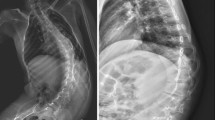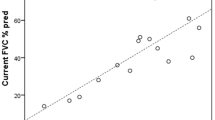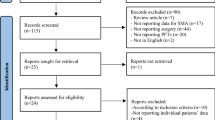Abstract
Purpose
Posterior instrumented spinal fusion is indicated for progressive scoliosis that develops in Duchenne muscular dystrophy (DMD) patients. Whilst spinal fusion is known to improve quality of life, there is inconsistency amongst the literature regarding its specific effect on respiratory function. Our objective was to determine the effect of scoliosis correction by posterior spinal fusion on respiratory function in a large cohort of patients with DMD. Patients with DMD undergoing posterior spinal fusion were compared to patients with DMD not undergoing surgical intervention.
Methods
An observational study of 65 patients with DMD associated scoliosis, born between 1961 and 2001: 28 of which underwent correction of scoliosis via posterior spinal fusion (Surgical Group) and 37 of which did not undergo surgical intervention (Non-Surgical Group). Pulmonary function was assessed using traditional spirometry. Comparisons were made between groups at set times, and by way of rates of change over time.
Results
There was no correlation between the level of respiratory dysfunction and the severity of scoliosis (as measured by Cobb angle) for the whole cohort. The Surgical Group had significantly worse respiratory function at a comparable age pre-operatively compared to the Non-Surgical Group, as measured by per cent predicted forced vital capacity (p = 0.02) on spirometry. The rate of decline of forced vital capacity and per cent predicted forced vital capacity was not slowed following surgery compared to the non-operated cases. There was no significant difference in survival between the two groups.
Conclusions
Severity of scoliosis was not a key determinant of respiratory dysfunction. Posterior spinal fusion did not reduce the rate of respiratory function decline. These two points suggest that intrinsic respiratory muscle weakness is the main determinant of decline in respiratory function in DMD.



Similar content being viewed by others
Notes
FVC maximum volume of air exhaled from lungs, following maximal inspiration.
%FVC FVC as a percentage of that predicted for a person of the same sex, age, and height.
References
Hoffman EP, Fischbeck KH (1988) Characterization of dystrophin in muscle-biopsy specimens from patients with Duchenne’s or Becker’s muscular dystrophy. N Engl J Med 318(21):1363–1368
Marsh A, Edge G, Lehovsky J (2003) Spinal fusion in patients with Duchenne’s muscular dystrophy and a low forced vital capacity. Eur Spine J 12(5):507–512
Kennedy JD, Staples AJ, Brook PD et al (1995) Effect of spinal surgery on lung function in Duchenne muscular dystrophy. Thorax 50(11):1173–1178
Emery A, Muntoni F (2003) Duchenne muscular dystrophy. Oxford University Press, Oxford
Eagle M, Bourke J, Bullock R et al (2007) Managing Duchenne muscular dystrophy–the additive effect of spinal surgery and home nocturnal ventilation in improving survival. Neuromuscul Disord 17(6):470–475
Smith AD, Koreska J, Moseley CF (1989) Progression of scoliosis in Duchenne muscular dystrophy. J Bone Joint Surg Am 71(7):1066–1074
Oda T, Shimizu N, Yonenobu K et al (1993) Longitudinal study of spinal deformity in Duchenne muscular dystrophy. J Pediatr Orthop 13(4):478–488
Khan Y, Heckmatt JZ (1994) Obstructive apnoeas in Duchenne muscular dystrophy. Thorax 49(2):157–161
Smith PE, Calverley PM, Edwards RH (1988) Hypoxemia during sleep in Duchenne muscular dystrophy. Am Rev Respir Dis 137(4):884–888
Manzur AY, Kinali M, Muntoni F (2008) Update on the management of Duchenne muscular dystrophy. Arch Dis Child 93(11):986–990
Velasco MV, Colin AA, Zurakowski D et al (2007) Posterior spinal fusion for scoliosis in Duchenne muscular dystrophy diminishes the rate of respiratory decline. Spine (Phila Pa 1976) 32(4):459–465
Simonds AK, Muntoni F, Heather S, Fielding S (1998) Impact of nasal ventilation on survival in hypercapnic Duchenne muscular dystrophy. Thorax 53(11):949–952
Eagle M, Baudouin SV, Chandler C et al (2002) Survival in Duchenne muscular dystrophy: improvements in life expectancy since 1967 and the impact of home nocturnal ventilation. Neuromuscul Disord 12(10):926–929
Granata C, Merlini L, Cervellati S et al (1996) Long-term results of spine surgery in Duchenne muscular dystrophy. Neuromuscul Disord 6(1):61–68
Miller RG, Chalmers AC, Dao H et al (1991) The effect of spine fusion on respiratory function in Duchenne muscular dystrophy. Neurology 41(1):38–40
Sussman MD (1984) Advantage of early spinal stabilization and fusion in patients with Duchenne muscular dystrophy. J Pediatr Orthop 4(5):532–537
Arun R, Srinivas S, Mehdian SM (2010) Scoliosis in Duchenne’s muscular dystrophy: a changing trend in surgical management: a historical surgical outcome study comparing sublaminar, hybrid and pedicle screw instrumentation systems. Eur Spine J 19(3):376–383
Rideau Y, Glorion B, Delaubier A et al (1984) The treatment of scoliosis in Duchenne muscular dystrophy. Muscle Nerve 7(4):281–286
Brook PD, Kennedy JD, Stern LM et al (1996) Spinal fusion in Duchenne’s muscular dystrophy. J Pediatr Orthop 16(3):324–331
Galasko CS, Delaney C, Morris P (1992) Spinal stabilization in Duchenne muscular dystrophy. J Bone Joint Surg Br 74(2):210–214
Miller F, Moseley CF, Koreska J (1992) Spinal fusion in Duchenne muscular dystrophy. Dev Med Child Neurol 34(9):775–786
Gayet LE (1999) Surgical treatment of scoliosis due to Duchenne muscular dystrophy. Chirurgie 124(4):423–431
Kinali M, Messina S, Mercuri E et al (2006) Management of scoliosis in Duchenne muscular dystrophy: a large 10-year retrospective study. Dev Med Child Neurol 48(6):513–518
Brooke MH, Fenichel GM, Griggs RC et al (1989) Duchenne muscular dystrophy: patterns of clinical progression and effects of supportive therapy. Neurology 39(4):475–481
Kurz LT, Mubarak SJ, Schultz P et al (1983) Correlation of scoliosis and pulmonary function in Duchenne muscular dystrophy. J Pediatr Orthop 3(3):347–353
Cobb J (1948) Outline for the study of scoliosis. Instr Course Lect 5:261–275
Tsiligiannis T, Grivas T (2012) Pulmonary function in children with idiopathic scoliosis. Scoliosis 7(1):7
Miller F, Mosely CF, Koreska J, Levison H (1988) Pulmonary function and scoliosis in Duchenne dystrophy. J Pediatr Orthop 8(2):133–137
Young HK, Lowe A, Fitzgerald DA et al (2007) Outcome of non-invasive ventilation in children with neuromuscular disease. Neurology 68(3):198–201
Toussaint M, Steens M, Soudon P (2007) Lung function accurately predicts hypercapnia in patients with Duchenne muscular dystrophy. Chest 131(2):368–375
Bourke SC, Gibson GJ (2002) Sleep and breathing in neuromuscular disease. Eur Respir J 19(6):1194–1201
Kennedy JD, Martin AJ (2009) Chronic respiratory failure and neuromuscular disease. Pediatr Clin North Am 56(1):261–273 xii
Modi HN, Suh SW, Hong JY et al (2010) Treatment and complications in flaccid neuromuscular scoliosis (Duchenne muscular dystrophy and spinal muscular atrophy) with posterior-only pedicle screw instrumentation. Eur Spine J 19(3):384–393
Acknowledgments
AJ Martin (Respiratory Physician, Women’s and Children’s Hospital, Adelaide, South Australia), The Department of Sleep Medicine (Women’s and Children’s Hospital, Adelaide, South Australia).
Conflict of interest
None of the authors or their family members have received financial benefits from any commercial party for this manuscript.
Author information
Authors and Affiliations
Corresponding author
Rights and permissions
About this article
Cite this article
Alexander, W.M., Smith, M., Freeman, B.J.C. et al. The effect of posterior spinal fusion on respiratory function in Duchenne muscular dystrophy. Eur Spine J 22, 411–416 (2013). https://doi.org/10.1007/s00586-012-2585-4
Received:
Revised:
Accepted:
Published:
Issue Date:
DOI: https://doi.org/10.1007/s00586-012-2585-4




